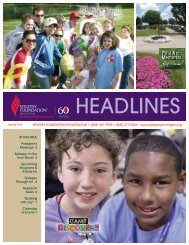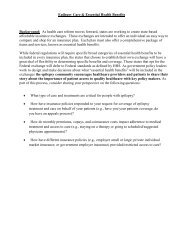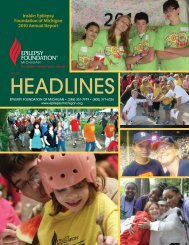Legal Rights of Children with Epilepsy in School & Child Care
Legal Rights of Children with Epilepsy in School & Child Care
Legal Rights of Children with Epilepsy in School & Child Care
Create successful ePaper yourself
Turn your PDF publications into a flip-book with our unique Google optimized e-Paper software.
What Laws Apply to <strong><strong>Child</strong>ren</strong> <strong>with</strong> <strong>Epilepsy</strong>?<br />
retardation, organic bra<strong>in</strong> syndrome, emotional or mental illness, and specific<br />
learn<strong>in</strong>g disabilities.” 34 C.F.R. 104.3(j)(2)(i).<br />
2.19 Q: Are all people <strong>with</strong> epilepsy automatically covered by Section 504?<br />
A: Probably not. The United States Supreme Court held <strong>in</strong> Sutton v. United<br />
Airl<strong>in</strong>es, Inc., 527 U.S. 471 (1999), a case <strong>in</strong>terpret<strong>in</strong>g the ADA, that, <strong>in</strong><br />
determ<strong>in</strong><strong>in</strong>g if an impairment “substantially limits” a major life activity, it is<br />
necessary to look at any measures the person has taken to mitigate or m<strong>in</strong>imize<br />
the impairment, such as medications or assistive devices like eyeglasses or<br />
prosthetics. Because the def<strong>in</strong>ition <strong>of</strong> disability under the ADA is identical to the<br />
def<strong>in</strong>ition conta<strong>in</strong>ed <strong>in</strong> Section 504, the Sutton hold<strong>in</strong>g appears equally<br />
applicable to Section 504. Therefore, if a person <strong>with</strong> epilepsy has wellcontrolled<br />
seizures or has mild seizures that do not substantially limit a major<br />
life activity, and does not have significant side effects from antiepileptic<br />
medication, he or she will not be considered disabled unless he or she meets one<br />
<strong>of</strong> the other prongs <strong>of</strong> the def<strong>in</strong>ition — i.e., has a record <strong>of</strong> such an impairment<br />
or is regarded as hav<strong>in</strong>g such an impairment. However, a student who requires<br />
school personnel to adm<strong>in</strong>ister antiepileptic medication to him or her dur<strong>in</strong>g the<br />
school day would be covered under Section 504 even if his or her seizures were<br />
well controlled. See Chapter 5 for further discussion <strong>of</strong> Section 504 and special<br />
education.<br />
2.20 Q: What is a “major life activity” under Section 504?<br />
A: Major life activities <strong>in</strong>clude functions such as walk<strong>in</strong>g, see<strong>in</strong>g, hear<strong>in</strong>g, car<strong>in</strong>g<br />
for one’s self, speak<strong>in</strong>g, breath<strong>in</strong>g, learn<strong>in</strong>g and work<strong>in</strong>g. 34 C.F.R.<br />
104.3(j)(2)(ii).<br />
2.21Q: What are the requirements <strong>of</strong> Section 504 for public school systems?<br />
A: Public school systems must provide a free appropriate public education to each<br />
“qualified handicapped person” <strong>in</strong> the jurisdiction regardless <strong>of</strong> the nature or<br />
severity <strong>of</strong> the person’s disability. A person is qualified if he or she is <strong>of</strong> an age<br />
at which children <strong>with</strong>out disabilities attend school or at which state law<br />
mandates that education services be provided to children <strong>with</strong> disabilities. An<br />
appropriate education is regular or special education <strong>with</strong> related aids and<br />
services that “are designed to meet <strong>in</strong>dividual educational needs <strong>of</strong> handicapped<br />
people as adequately as the needs <strong>of</strong> nonhandicapped people are met” and that<br />
meet the requirements <strong>of</strong> the regulations. 34 C.F.R. 104.33. 13<br />
13 The Education Department’s Section 504 regulations use the terms “handicap” and “handicapped<br />
persons.” However, Section 504 itself, consistent <strong>with</strong> the language used <strong>in</strong> the ADA, <strong>in</strong>stead makes<br />
reference to “disability” and “<strong>in</strong>dividuals <strong>with</strong> disabilities.” The regulations have not yet been revised to<br />
adopt this more current and preferable language.<br />
22








